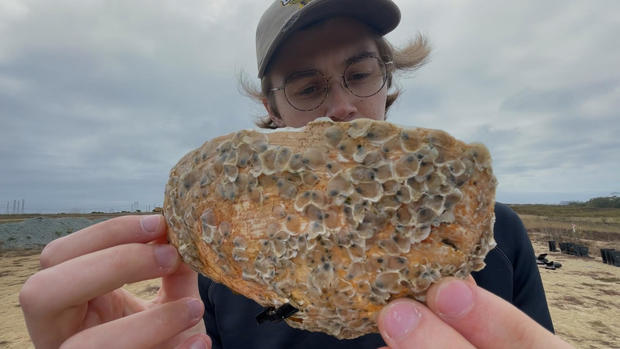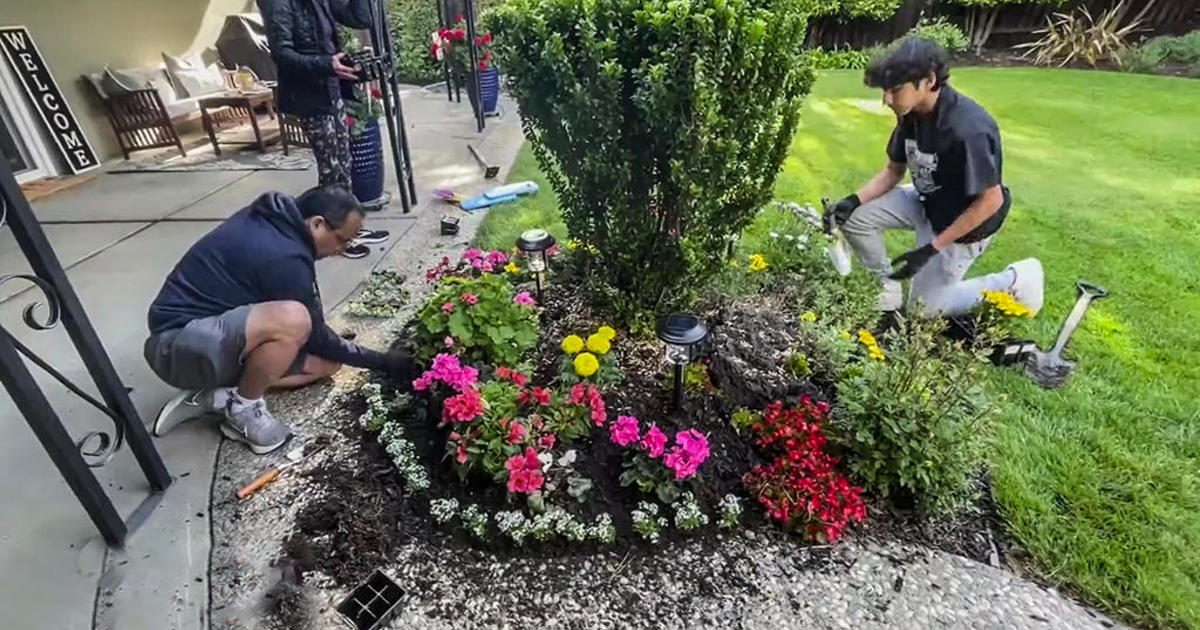Revival of once-abundant Olympia oyster population could help fight effects of climate change
Scientists, researchers, and volunteers are working on an Olympian quest - to restore the Olympian oyster to once-historic levels at a coastal wetland along the Monterey Bay, an effort that may help to curb the impacts of the warming climate.
At the legendary Swan Oyster Depot in San Francisco, the line forms early. If you're lucky to get a seat at the seafood counter, you're in for a treat: the restaurant just got a fresh shipment of the only oyster native to the West Coast of North America.
The Olympia oyster, native to the Puget Sound area and named after Olympia, Washington, is as small as a silver dollar but big in flavor. They are described as slightly briny with a coppery finish.
"I grew up eating these oysters and I think they're just fantastic," exclaimed Swan co-owner Steve Sancimino
Olympias are not endangered, but their once-abundant numbers have dramatically declined, largely due to overharvesting and mining practices during California's Gold Rush, as well as persistent problems of pollution and loss of habitat.
Scientists, researchers, and volunteers are working to restore the Olympias to their historic levels in the wild. At this point, the Olympia oysters are not able to reproduce at numbers that can be self-sustaining.
One Bay Area restoration site is located at one of California's largest estuaries.
"We are here to bring back oysters to Elkhorn Slough where they have lived for millennia," explained Dr. Kerstin Wasson, who heads up the pioneering restoration project at the slough and works for NOAA's National Estuarine Research Reserve. "We're doing it with optimism and hoping that if we can bring back a million oysters to Elkhorn Slough, they'll be self-sustaining. And today is one step towards that goal."
In the slough, because of agricultural runoff from the Salinas River, the restored oysters won't be harvested. But their intended role is big and critical: to filter water, stabilize the shoreline, sequester carbon, and provide habitat for other creatures - all big benefits as the planet warms.
"It's really important that we help to restore this population," said Dr. Luke Gardner, who works for California Sea Grant as an aquaculture extension specialist. He also works for Moss Landing Marine Laboratories, which is administered by San Jose State University.
At the lab's aquaculture hatchery, specialists "borrow" adult Olympias from the wild at Elkhorn Slough and bring them back to the hatchery to breed baby oysters that will be involved in the restoration effort.
"In a hatchery, we can control a lot of the environment and we can make sure those little babies make it through to being juveniles," noted Gardner.
The baby oysters require tender loving care: micro-algae for food, the right temperatures, protection from predators, and plenty of fresh water.
"They're very needy and very dirty so they are really fun to take care of, but they need a lot of attention," said Moss Landing Marine Lab scientist Jacob Harris.
Harris told CBS News Bay Area that when the baby oysters are ready, they attach to hard surfaces, including large clam shells that are also collected from the slough. Gardner and Harris carefully gather the oyster-encrusted clam shells, put them in special mesh bags, and pack them in a cooler.
They also collected baby Olympias from their water-filled silos and put them in plastic tubs to be loaded into the van headed to Elkhorn Slough There, scientists and volunteers enthusiastically jumped into action to unpack the precious cargo.
California State University, Monterey Bay student Taylor Garcia is aware of the world's warming change and says she wants to be part of the solution.
"There always has to be optimism when it comes to this line of work," said Garcia. "I guess because without it, you really wouldn't get anywhere."
The work is unusual but makes a lot of sense. Each volunteer is tasked with counting each baby oyster stuck to a shell or floating in a small container of water. They then measure the largest one that they can spy on each shell. They then record their findings on an iPad and secure each clamshell to PVC pipes tagged with a unique identifying number.
Once all the oysters are counted, secured, and tagged - there were about 80,000 baby oysters on all the shells - the volunteers picked up the PVC pipes, and now clad in rubber boots, caravaned with their treasures down to the estuary. There, the volunteers formed a brigade, carefully passing the pipes down to the scientists, who planted them into the muddy goop and low tidal waters of Hester Marsh. The scientists will continue to monitor these sites and record what happens with each group of oysters.
"The oysters have been here for 7,000 years and on my watch, I don't want to see them disappear from Elkhorn Slough," said Wasson, as she lined up the pipes.
Back at Swan's, patrons thought the effort was well worth it. If they can restore the oysters in the wild at Elkhorn Slough, perhaps they'll see more of all kinds of oysters growing in the wild.
"I think it's a great initiative. It benefits not only the environment but also folks who truly love oysters. So, I think it's a win-win for everybody," said customer Phirun Pheap.
It didn't matter to Sancimino that these oysters were not intended to be harvested and eaten. He said that was not the point, and applauded the scientists and researchers involved.
"I'll be honest with you, if what they're trying to establish down in the slough works, that'll be one step closer to reviving a native species and putting it where it belongs in this state," declared Sancimino, as he offered fresh Olympias to his happy customers.





